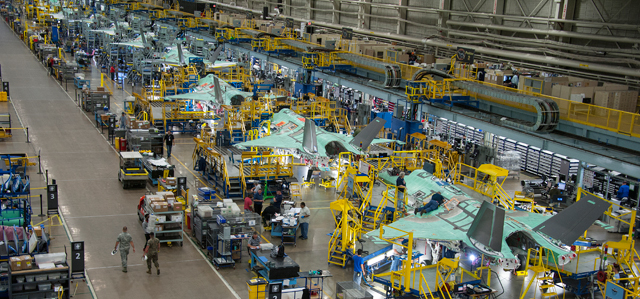Lockheed Martin chief executive Marillyn Hewson said she was assured by Department of Defense officials that any order of Boeing F-15 aircraft will not come at the expense of future Lockheed Martin F-35 Lightning II purchases.
Hewson was responding on a 29 January earnings call to rumours that the US Air Force might buy F-15 fighters to fill a hole in its future inventory caused by delayed F-35 deliveries.
“In terms of the F-35, it is well supported across the board, regardless of whatever platform the Department of Defense is looking at,” she says. “If they chose to have an order of the F-15, it won’t be at the expense of the F-35 quantities. I’m hearing that directly from leadership in the Pentagon.”
Hewson adds that F-35 orders for the USA and international customers ought to remain steady in the coming years, and could possibly expand.
“The F-35 is in the competitions in Switzerland, Finland and Germany, and a whole range of countries,” she says. “We expect to continue to see growth in international demand.”

Lockheed Martin F-35 Lightning II in production in Fort Worth, Texas
Lockheed Martin
In November, Lockheed Martin won a $22.7 billion contract for Lots 12, 13 and 14 to supply 255 F-35 Lightning II stealth fighters for the three branches of the US armed services and international operators. The company says that order was not complete and it expects it to grow further to a total of 478 aircraft once finalised.
“Our F-35 backlog has grown to over 400 planes – a level which exceeds the total number of F-35 deliveries we have made to date,” says Hewson.
The manufacturer’s growing backlog comes as it tries to rapidly ramp up its production schedule. It delivered 91 F-35 aircraft to the USA and international customers in 2018, rising from 66 stealth fighter deliveries in 2017. The company is aiming to increase its output another 40% in 2019 by delivering 130 units. By 2021, the defence firm plans to manufacture more than 160 F-35 aircraft annually.
Ultimately, it is hoping for a large-quantity, multiyear agreement around 2022, said Bruce Tanner, chief financial officer of Lockheed Martin. Its facilities have the capacity to accommodate production of up to 180 F-35 aircraft per year.
The F-35 is also starting to generate supplemental upgrade business, said Tanner.
“Somewhat surprising, the fastest growing part of the F-35 programme on a percentage basis is actually the development programme,” he says. “And that is because we are starting to get modifications on the aircraft, some international peculiar updates for improvements.”
Hewson also addressed the impact of the recent 35-day partial US government shutdown.
"The previous closure of these agencies did not have significant impact on this year's financial metrics, as the vast majority of our business is currently funded through the DoD's FY19 appropriations bill," she says. "Should a budget impasse reoccur after the three week continuing resolution expires, it is possible we could see some delays in 2019 awards and orders."
Lockheed Martin’s net sales in 2018 were $53.8 billion, a 7.6% increase from the year before. Net earnings from operations in 2018 were $5 billion, a 157% increase from the year prior when the company took a nearly $2 billion one-time charge related to the impact of the Tax Act.
The company projects net 2019 sales to be between $55.8 billion $57.3 billion, while operating profit in 2019 is forecast to be $6 billion to $6.2 billion.
The company’s aeronautics division, which produces the F-35 and F-16, had net sales in 2018 of $21.2 billion, rising 9.4% from the year prior. The increase was primarily because of larger production volume and sustainment work for the F-35, says Lockheed Martin.
Source: FlightGlobal.com






















